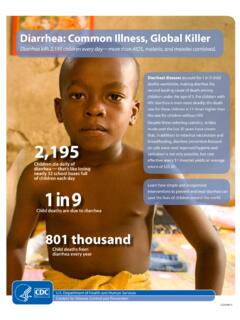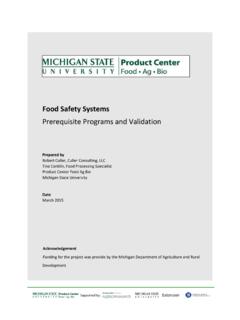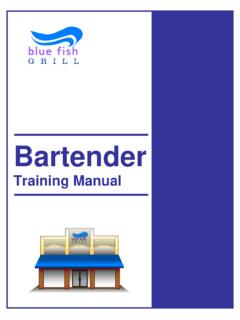Transcription of Water, sanitation, hygiene and health
1 water , sanitation , hygiene and healthA PRIMER FOR health PROFESSIONALSW ater, sanitation , hygiene and healthA PRIMER FOR health PROFESSIONALSWHO/CED/PHE/ World health Organization 2019 Some rights reserved. This work is available under the Creative Commons Attribution-NonCommercial-ShareAlike IGO licence (CC BY-NC-SA IGO; ). Under the terms of this licence, you may copy, redistribute and adapt the work for non-commercial purposes, provided the work is appropriately cited, as indicated below. In any use of this work, there should be no suggestion that WHO endorses any specific organization, products or services. The use of the WHO logo is not permitted. If you adapt the work, then you must license your work under the same or equivalent Creative Commons licence.
2 If you create a translation of this work, you should add the following disclaimer along with the suggested citation: This translation was not created by the World health Organization (WHO). WHO is not responsible for the content or accuracy of this translation. The original English edition shall be the binding and authentic edition . Any mediation relating to disputes arising under the licence shall be conducted in accordance with the mediation rules of the World Intellectual Property citation. water , sanitation , hygiene and health : a primer for health professionals. Geneva: World health Organization; 2019 (WHO/CED/PHE/ ). Licence: CC BY-NC-SA (CIP) data. CIP data are available at , rights and licensing.
3 To purchase WHO publications, see To submit requests for commercial use and queries on rights and licensing, see Third-party materials. If you wish to reuse material from this work that is attributed to a third party, such as tables, figures or images, it is your responsibility to determine whether permission is needed for that reuse and to obtain permission from the copyright holder. The risk of claims resulting from infringement of any third-party-owned component in the work rests solely with the disclaimers. The designations employed and the presentation of the material in this publication do not imply the expression of any opinion whatsoever on the part of WHO concerning the legal status of any country, territory, city or area or of its authorities, or concerning the delimitation of its frontiers or boundaries.
4 Dotted and dashed lines on maps represent approximate border lines for which there may not yet be full mention of specific companies or of certain manufacturers products does not imply that they are endorsed or recommended by WHO in preference to others of a similar nature that are not mentioned. Errors and omissions excepted, the names of proprietary products are distinguished by initial capital reasonable precautions have been taken by WHO to verify the information contained in this publication. However, the published material is being distributed without warranty of any kind, either expressed or implied. The responsibility for the interpretation and use of the material lies with the reader.
5 In no event shall WHO be liable for damages arising from its use. Design and layout by LT DesignPrinted in Switzerland Contents WHY THIS PRIMER? ..1 WASH-RELATED health BURDEN KEY FACTS ..2 WASH-related health burden 2 Infectious disease risks 4 health risks from chemicals in drinking- water 8 Impacts on social and economic well-being 8 Burden on health systems and economies 9 WHAT ARE WASH INTERVENTIONS? ..10 WHAT IS THE SITUATION GLOBALLY? ..12 Global policy context 12 Access to WASH services 14 Households 14 health care facilities 17 Schools 18 WASH systems and finance 19 WHY DOES WASH MATTER FOR health PROGRAMMES?
6 20 HOW CAN health PROFESSIONALS ENGAGE ON WASH ISSUES? ..22 MAIN WHO ACTIONS ON WASH ..24 Key actions 24 Priority areas 25 WASH within WHO s thirteenth general programme of work 2019 2023 (GPW 13) 26 SELECTED PUBLICATIONS ..27 REFERENCES ..28 iiiA primer on WASH and health for health professionals 1 Why this primer?Safe water , sanitation and hygiene (collectively known as WASH) are crucial for human health and well-being. Yet, millions of people globally lack adequate WASH services and consequently suffer from or are exposed to a multitude of preventable illnesses.
7 Lack of safe WASH negatively impacts quality of life and undermines fundamental human rights. Poor WASH services also weaken health systems, threaten health security and place a heavy strain on economies. So, what can health professionals do to maximize positive impacts from WASH interventions? This primer aims to guide health professionals on engaging with WASH-related issues. It gives an overview of WASH interventions and the status of WASH services globally and outlines key linkages with health . It provides examples of key actions that health actors can take to ensure WASH efforts effectively protect public health and highlights World health Organization (WHO) activities to support those actions.
8 A primer on WASH and health for health professionals 1 INFECTIOUSDISEASES AND RISKSHEALTH RISKS FROM CHEMICALS IN DRINKING WATERIMPACTS ON WELL BEINGC hild deathsDiarrhoeal disease, enteric infections and related sequelae ( undernutrition)Neglected tropical diseasesHealth care-associated infectionsMaternal and neonatal sepsisInfections from unsafe health care waste managementAntimicrobial resistanceNoncommunicable diseasesArsenicosis, fluorosisEmerging risks ( pharmaceuticals, endocrine disruptor chemicals, microplastics)Dignity, personal safety (fear, anxiety, stress), school attendance, livelihoods, (economic productivity, poverty)In health care facilities:Safety, sta morale, health care- seeking behaviourPRESSURES ( Climate change, urbanization, population growth, use of antibiotics etc.)
9 WASH-related burden key factsWASH-RELATED health BURDENWASH-related diseases and risks are wide ranging (Fig. 1). They include infections transmitted by the faecal oral route, health impacts from exposures to chemicals and other contaminants in drinking- water , as well as impacts on well-being. WASH-related diseases and risks can be exacerbated by a number of factors including climate change, population growth, rapid urbanization or, in the case of antimicrobial resistance, antibiotic use. Fig. 1 | WASH-related diseases and risks2A primer on WASH and health for health professionals 3 Worldwide, in 2016, million deaths and 123 million disability-adjusted life-years (DALYs) could have been prevented with adequate WASH (Table 1).
10 The WASH-attributable disease burden amounts to of global DALYs and of global deaths. The burden of deaths among children under 5 years is 13%.1 DISEASEDEATHSD A LY S (THOUSANDS)POPULATION-ATTRIBUTABLE FRACTIOND iarrhoeal diseases828 65149 7 helminth infections6 2483 4311 Acute respiratory infections370 37017 1942 6 Trachoma<102441 Schistosomiasis10 4051 filariasis< BTOTA L: drinking- water , sanitation and hygiene1 243 86975 630 NAMalaria354 92429 3152 < 0SU BTOTA L : water resource management393 23932 740 NADrownings233 89014 SU BTOTA L : safety of water environments233 89014 723 NATOTAL : inadequate water , sanitation and hygiene1 870 998123 093 NATable 1.












